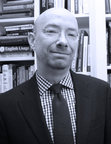Bill Walsh's Blog
March 29, 2017
Bill Walsh, 1961-2017
Bill Walsh, a Washington Post copy editor who wrote three irreverent books about his craft, noting evolutions and devolutions of language, the indispensability of hyphens and his hostility toward semicolons, and distinctions - for the sake of clarity - between Playboy Playmates and Playboy Bunnies, died March 15 at a hospice center in Arlington, Va. He was 55.
Read the full Washington Post obituary
ACES is establishing a Bill Walsh Scholarship to support students interested in a career in news editing.
Donate to the ACES Bill Walsh Scholarship
(Note from the Mrs.: Thank you to all who have sent messages of condolences. It has been heartbreaking to lose Bill, but the genuine outpouring to his death has been a source of tremendous comfort.)
Published on March 29, 2017 14:12
January 28, 2017
Health Update 5
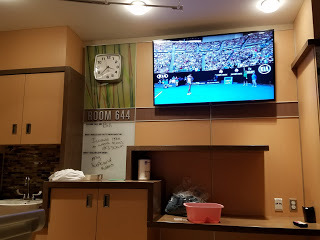
I am home from my first major surgery and first overnight hospital stay.I have crutches (another first). I have a titanium rod (or “nail,” as my dapper and congenial surgeon calls it) in my left femur. The thigh that surrounds said femur is itself surrounded by a brace that immobilizes the knee. Dapper and Congenial Sawbones and his resident led me to believe that I could ditch the brace at any time and re-enact the Fred Astaire ceiling dance. The nurse I asked to remove it strongly disagreed.
The nurse was right, as I learned in the quickie physical-therapy session I went through before discharge. So the next couple of days are going to suck, as I maneuver around this two-story house with two crutches and one functional knee.The “nerve block” that was injected into my femoral artery hasn’t quite worn off yet, but at this point my leg hurts less than it did before the surgery. That tumor really was stretching the bone to the breaking point. (I asked DACS whether he scooped the cancerous tissue out with a melon baller, and he said no -- and then proceeded to describe the tool he did use, defining a melon baller with the kind of precision that could get him a job at Merriam-Webster.)The surgery went well from my perspective, but apparently I slept through some drama. DACS wanted to start with a biopsy just to make sure this was the metastasis we had expected and not, in a horrible coincidence, an unrelated bone tumor. So they did that -- and found no evidence of any sort of cancer. They did it again -- and found some “abnormalities” but still no cancer. The third time was a charm: While it wasn’t definitive, and really nothing is with my rare form of a rare cancer that rarely spreads to the bones, it was at least “consistent” with that scenario.Funny thing is, when I woke up, I was very confused when the nurses told me everything went well, because I could have sworn I had previously been awakened and told the operation was aborted because it had been bone cancer and not a metastasis all along.Apart from the actual medical stuff, the hospital stay was quite pleasant. The room, in the new wing at Sibley Memorial Hospital in D.C., could have been in a Hampton Inn. I ordered food; I wasn’t just issued it. There were the usual constant intrusions for medication and vital signs, but they made it easy not to miss the Australian Open women’s singles final at 3 a.m. on my room's nice flat-screen TV -- too bad Venus couldn’t pull off the upset.
Published on January 28, 2017 15:00
January 26, 2017
Health Update 4

It hasn't been long since my last update, but I have plenty of "content," as the kids say.
Jacqueline and I have talked to a handful of people at the National Cancer Institute, part of the National Institutes of Health, and they have been helpful and encouraging. I'm not a candidate for the "bubble boy" immunotherapy trial ("It's MOORS! There's no MOOPS!"), but that was more of a down-the-road option and, in very good news, I would qualify for the trial we wanted to do first.
The zapping of the neck has just concluded, and I'm feeling much better on that front. Probably 80 percent or so back to normal. I can sleep normally. That process got off to a painful start. First came the torturous MRI. Then, in the first of five radiation sessions, I was fitted for a head restraint that looks like a goalie mask. I lay on the MRI-style table while technicians stretched soft plastic tightly over my head and neck. That plastic hardened, and it was used to firmly hold my head still during the zapping. After what seemed like an hour of this agony, one of the techs said, "OK, Mr. Walsh, we're about ready to start the treatment." Thankfully, the next four treatments were much less grueling.
Once the neck pain started to subside, however, an old nemesis lurched to the fore:
My stupid leg.
That knee pain that turned out to be related to even more cancer was suddenly much more acute. I had been complaining about it for months, but I turned up the volume and my main oncologist at Sibley Memorial referred me to an impressively credentialed radiation oncologist there. That doctor ordered up MRI No. 1,367, and when she looked at it, she immediately saw what could well have been a fracture of my femur. She grabbed her cellphone and reached yet another impressively credentialed specialist at Sibley. This was on Wednesday, and the oncology-focused orthopedic surgeon said I should come in Thursday.
She also said I should get crutches or a cane. I chose the latter. It was my first experience with either.
At Thursday's appointment, the dapper and congenial Sawbones of Doom (the first male doctor to play a significant role in my treatment) said I really, really needed to have a titanium rod implanted in my femur. He said the bone was straining to keep up with a fast-growing tumor expanding inside it, and he painted a vivid picture of the superiority of doing that to suffering, repairing and recovering from a fracture.
DOCTOR: "And we cap it off with a locking screw to prevent twisting."
ME: "Or theft!"
This was on Thursday, and the surgeon said he could operate Friday. So, yeah, tomorrow. Crack of dawn. And the room was booked for the night -- first my first cane, and now my first real surgery and -- unless they spring me for good behavior -- overnight hospital stay. Woo-hoo!
The doctor described the operation and the recovery as a breeze. I'll be able to walk immediately, though I should use crutches at first. I'm skeptical, but whatever. I'd really rather not add broken bone to this week's list of lifetime firsts.
I'm not a religious person, but if you are, please put in a good word for Roger Federer and Venus Williams. Hope that hospital room has ESPN.
Published on January 26, 2017 16:57
January 5, 2017
Health Update 3

"Your body likes to grow things," Dr. Zamskaya told me a few years back, in a simpler time when my main health concerns were moles and freckles and seborrheic keratosis, a.k.a. geriatric warts, though I prefer "barnacles."
And, unfortunately, my body continued to grow things during the clinical drug trial I've been on for the past eight weeks. So Jacqueline and I will stop trekking to Philadelphia and start looking for another trial. Or something.
The news wasn't as crushing as it might have been. For about five minutes the day after Christmas, my most annoying recent symptom -- a near-constant sensation of a full stomach -- went away. If anything, the symptoms were backtracking and I felt pretty much the way I did in April and May, before my diagnosis. We could very well have been headed to Philadelphia with very high hopes.
But on Dec. 27, I woke up with a painful stiff neck. At first I had no reason to believe it was due to anything other than bad posture as I watched the Holiday Bowl in bed the night before (my new fondness for football has to rank among the oddest symptoms of any ailment), but that kind of stiff neck usually goes away in three or four days. This one didn't. My wife the Prophet of Doom suspected a new metastatic bone lesion from the start, and she was apparently right.
We had expected to learn the verdict on the Philadelphia experiment during today's appointment at Penn Presbyterian, but the neck pain sent me to Sibley Memorial in Washington for a spine MRI the day before, and we got spoiled. The scan found one new lesion, high enough on the spine to be a prime suspect. By the way, I do not recommend being forced to lie still on a tiny pillow for two hours in an MRI machine when the problem in the first place is an inability to get comfortable in any position. I toss and turn every five to 10 seconds in bed even when I can choose any position and any combination of pillows I like, so a couple of hours frozen in somebody else's choice of position is no less than torture.
It's still possible that this is a good old-fashioned stiff neck, but we'll get the radiation-oncology team to zap the new lesion ASAP rather than wait around for it to heal itself. And, just to be sure I don't get my hopes up about feeling A-OK after that zapping, the gods gave me some new pain overnight, the kind of pain you'd expect to feel in the liver region if you have a gigantic liver tumor.
But we're not giving up. Georgetown has some promising clinical trials coming soon, and NIH isn't too much farther up Wisconsin Avenue.
Published on January 05, 2017 12:29
November 28, 2016
Compound-Modifier Hyphenation, Extreme Edition
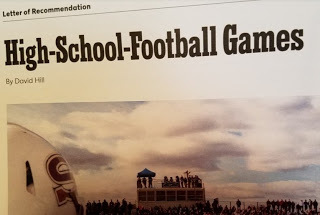
Early in my journalism education, I was taught the school of thought that all compound modifiers should be hyphenated -- "except high school."
The logic isn't hard to follow. Especially in sports coverage, the linkage is obvious and the punctuation would be rampant. And even making that your lone exception is an extreme position, at least in the bell-curve sense. In the real world, few would hyphenate ice cream cone or peanut butter sandwich or real estate agent or law enforcement officer. The list goes on.
Leave it to me to be more extreme still. I do hyphenate high-school football and the like, as well as ice-cream cone, peanut-butter sandwich, real-estate agent and law-enforcement officer.
But even I would never add a second hyphen to high-school football games.
The logic of the double hyphenation is at least debatable. In publishing the above headline, the New York Times Magazine is casting games as a noun that's being modified by high-school football.
"I'm going to a game tonight."To me, such a conversation would be more likely to go like this:
"Oh? What game?"
"High-school football."
"I'm going to a football game tonight."The sport is football. There is high-school football, college football and professional football, but the sport is football. High-school football is not a sport in itself.
"Oh? What football game?"
"High-school."
And even if the logic argument ended in a draw, I would invoke the "plausible deniability" clause. One could argue for special-needs student accommodation or special-needs-student accommodation, but why risk annoying hyphen-averse readers when the single-hyphen version is perfectly understandable and logically defensible?
Now then: By no means am I saying there's no place for the doubly hyphenated high-school-football. Whereas a debate within a high school about football would be a high-school football debate, a similar debate among taxpayers, lawmakers or the culture at large would most certainly be a high-school-football debate. The former is a high-school debate; the latter is not.
INCREMENTAL HEALTH UPDATE: Well, I still have cancer, as detailed here, here and here.
For the fourth consecutive week, my wife will drive me to Philadelphia to get a once-over exam and a new bottle of pills for the clinical trial I'm on. (Long story short: If you hear about "FGFR fusions" and "FGFR inhibitors," you're hearing about my condition and my treatment.)
I'm not thriving under this regimen the way I did under chemotherapy. The nausea is back, often accompanied by far-too-quick satiety and other unpleasant tummy symptoms. The left thighbone and the spine show no signs that their metastatic bone lesions have disappeared.
Still, these are minor complaints within the much bigger complaint. I'm pretty lucky to be feeling as good as I do under the circumstances.
We're at the halfway point, so we should get a look at images of my liver in four or five weeks to show whether the experimental drug shrank, or at least held steady, the tumors.
Published on November 28, 2016 07:29
November 10, 2016
Health Update 2
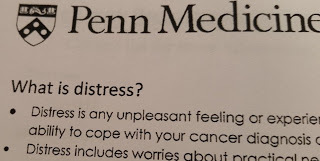
Now begins Round 2 of my cancer fight. I have joined a clinical trial of a drug that has shown promise in at least temporarily keeping the bad stuff at bay. This will require traveling -- weekly at first, then every two weeks -- the 135 miles from my home in Washington, D.C., to the University of Pennsylvania campus in Philadelphia.
The standard first-line treatment for my cancer -- cholangiocarcinoma, or cancer of the bile ducts -- is chemotherapy consisting of gemcitabine and cisplatin. There is no standard second-line treatment.
Different doctors said different things about my response to “gem/cis,” but Jacqueline -- my wife, chief advocate and one-woman research staff -- and I refer to it as mixed. The main liver tumor stayed more or less stable, but the cancer metastasized to my left thighbone and my spine. Because of those metastases, my main oncologist recommended against the targeted radiation treatment we had hoped to try next and encouraged us to get into a clinical trial of an experimental drug.
I was all set to join a trial being run by the National Cancer Institute at locations including two close to home: Sibley Memorial Hospital, the Johns Hopkins affiliate where I’m receiving most of my care, and nearby Georgetown University Hospital. That trial would have been a fine choice, but toward the last minute Jacqueline and I decided to pursue the Penn option, which is more specifically geared toward my rather rare situation.
There are about 2,500 new cases of bile-duct cancer every year in the United States. That’s one person in 100,000. Ain’t I special? But I get special-er. I have the intrahepatic form of the disease, with tumors contained within the liver, which accounts for about one in 10 cholangio cases.
And there’s more! Part of the modern treatment strategy, insofar as one exists, is to have a tumor sample tested for genetic mutations. I was lucky(!) to come back positive for the FGFR2 mutation, which in its fusion form (there is also the amplification form) is found in a minority (somewhere between 9 percent and 30 percent) of intrahepatic cases. Jacqueline found that the drug company behind the Penn trial had seen enough encouraging signs in patients with my subtype of my mutation in my subtype of my cancer to break out an arm of a larger study to look at just my situation.
While all that may sound swell, the fact is that this is an incurable disease. All the chemotherapy and radiation and experimental drugs and targeted genetic therapies and immunotherapy and even surgery (not even an option for me, now or probably ever) serve only to buy months or maybe, just maybe, years. Now, there are some signs that my mutation points to a more “indolent” form of the cancer, a bit of potential good news that I’m happy to hold tight, and maybe that means I get more time than most to kick the can down the road, as Jacqueline and I say. Better than kicking the bucket.
I’ve been fortunate so far, aside from the damn bone metastases. As I’ve reported in past updates, the chemotherapy, which is so devastating to so many patients, was a joy for me. The results were mixed, but the experience was nothing but pleasant. (The doctors and nurses assure me that they had never heard that before.) Then again, there are stupid setbacks. The pain medications I was initially on made me puke my guts out. Changing those made a world of difference. (For plenty of other people, my new medications are unbearable and my old ones work like a charm.) More recently, just last week, an infusion of a bone-strengthening drug resulted in perhaps the worst day I’ve had since I first got sick. Flu-like body and bone aches, headache, chills and hot flashes, vomiting (breaking a long streak!). I was fine the following day, only to find myself hunched over the toilet again this week. My best guess is that a new calcium-and-vitamin-D supplement was to blame. (Did I say stupid?)
But I’m still standing. I’ll take three pills a day for the trial, and have plenty of blood and urine tests and EKGs, but the first scans of my innards won’t be until the eight-week mark, and my doctor at Penn cautioned against expecting to see much of a change, though she was optimistic about the possibility of a “boring” but encouraging result: a tumor that stayed the same size.
“We don’t have magic pills,” she said.
“But I specifically requested the magic ones!” I replied.
Here’s hoping for at least a tiny bit of magic. And maybe some Philly cheesesteaks and hoagies and roast-pork sandwiches.
Published on November 10, 2016 20:44
August 26, 2016
A Health Update
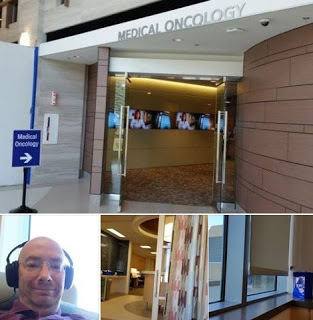
I've been walking five miles a day. Over the past week or two I've hit the pickleball court twice and the tennis court once. I appear to have hurt my left knee.
That damn knee really does hurt, without any obvious trip or slip or strain, but I'm sure you'll agree that all of the above is a pretty positive lede for a guy with Stage 4 intrahepatic cholangiocarcinoma who couldn't hold down a bite of food a few weeks earlier.
As crazy as it sounds, I feel good physically and even better emotionally. The forced "vacation" that is short-term disability is part of it, no doubt, but there's more. The psychology of borrowed time? I'm manic without depression, racing to tend to laundry and dishwasher chores, and often just deliriously happy for no good reason. My appetite is back with a vengeance, thanks in part to the steroids that come with the chemotherapy. Don't be surprised if the next entry here is a detailed analysis of Popeyes vs. KFC.
Now, my treatment is still in its first stage -- just chemo -- and it might be several weeks before the doctors stick me in the scan-o-tron to see whether the tennis-ball-size tumor in my liver has assumed more golf-ball-like proportions. But the anecdotal evidence sure doesn't suggest any move in the other direction. My blood tests aren't showing anything alarming under the circumstances. I'm still on an opioid (it's the American way!), but the pain is minor, and it's almost always "referred" pain that presents itself as a backache, not a flashing YOUR TUMOR HERE! neon sign on my abdomen.
About that chemotherapy:
A handful of things about my diagnosis have emerged as "lucky," and one of those is that it came just as Johns Hopkins was about to open a branch of its cancer center at Sibley Memorial Hospital, much closer to my home in Washington, D.C. The photos here are from my first visit to the new facility, with its private infusion rooms. This was the second and final infusion of Round 2 of chemotherapy -- a round is two visits in three weeks (infuse, infuse, rest).
Five or six hours in a chair sounds boring, but I could sit there twice as long. It is truly a highlight of my week. The nurses are smart and capable and funny. I have my books and my music and my Jacqueline. And aside from a little fatigue, I've escaped the side effects: I've had no nausea since starting chemotherapy, and I still have all my hair!
Soon we should be talking about the second stage of treatment, the tiny beads of radiation bombarding the big tumor directly. And in 40 years, give or take, they should be interviewing me for the documentary.
Published on August 26, 2016 11:39
August 2, 2016
The News Could Be Better
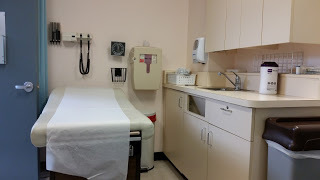
I recently learned -- gradually and then suddenly, like the bankrupt Hemingway character -- that I have cancer. Intrahepatic cholangiocarcinoma, to be precise. Stage 4, with a tennis-ball-size liver tumor and numerous little sidekick tumors. Not one of your kinder, gentler cancers.
Believe me, I have every intention of fighting and beating this thing. And my wife, Jacqueline, is helping me fight and beat this thing. I wouldn't bet on This Thing, quite frankly. Still, the odds are not in our favor, and we are nothing if not realistic. We are putting whatever faith we can muster in science aided by determination, not sunny affirmations or soft-focus memes. We will not shy from gallows humor.
For several years now, Jacqueline and I have looked at each other and shaken our heads and marveled at our good fortune. If we had behaved this way in front of other people, it would have seemed smug and boastful. But we really were grateful, and we still are. I have had a great life. I have a great wife, a great family, a great job, etc., etc. I would not trade 55 of these years for 75 or 85 or 95 of what's behind Door No. 2.
And isn't it lucky to have some warning, at a relatively young age and with my mind intact? Not all causes of death work that way -- I could have been run over by a car. This way, I have time, maybe a little and maybe more than that, to take it all in. To savor the little things. I get weepy now when I see trees and cardinals and cardinals in the trees. Am I really missing all that much if I never get to be a doddering old man?
Speaking of smug boasts, have I mentioned that I can swing neither of my cats without hitting a world-class cancer center? I chose one of the very best: Johns Hopkins is less than an hour a way, with a satellite even closer to home at Sibley Memorial Hospital (SMH, as in "shaking my head"). I've since learned that "my team of specialists" is a phrase that doesn't sound nearly as good as you think it's going to, but still, I have a team of specialists. And that team has a plan. I've started chemotherapy. Soon, there will be radiation, in the form of teeny-weeny little beads sent directly into the diseased area.
In other words, as lucky as I am to be escaping doddering-old-man status, maybe I'll be really lucky. Maybe I'll end up a doddering old man.
Published on August 02, 2016 04:30
April 4, 2016
ACES 2016

By popular request, here is the slide show that accompanied my presentation at the 2016 American Copy Editors Society conference in Portland, Oregon. The usual caveat: I don't use PowerPoint (or do much else, for that matter) like a normal person. I put up slides to illustrate and punctuate my points, and to give the audience something to look at besides my shiny head. So you won't see bullet points spelling out everything I said. There is a fair amount of text, but in some cases you'll have to use your imagination.
Rookie Mistakes That Even Veterans Make (PDF)
Published on April 04, 2016 08:18
January 14, 2016
[S]top [T]his
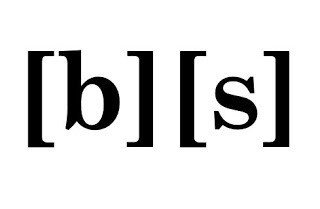 In academic publishing and other rigorously picky environments, single letters are bracketed to indicate a change of case in a quotation from written material -- a word from the middle of a quote being used to begin a sentence, or a word from the beginning of a sentence being used in the middle of running text.
In academic publishing and other rigorously picky environments, single letters are bracketed to indicate a change of case in a quotation from written material -- a word from the middle of a quote being used to begin a sentence, or a word from the beginning of a sentence being used in the middle of running text.Recently, the practice has extended beyond academia and taken the Web by storm. Some writers at Slate and Salon seemingly engineer their sentences so that the case at the beginning of a quote is never, ever in context, thus allowing them to use their [n]ew [t]oy.
Others seem to think the brackets are the new ellipses, to indicate that something came earlier but isn't being quoted. Any quote that does not begin with the first word the speaker uttered as an infant gets [T]he [T]reatment. Bizarrely, this happens even with spoken quotations, as though people spoke in big and little letters.
If you're writing or editing in a rigorously picky environment, go ahead and use those brackets. Otherwise, perhaps with the occasional exception, do not. If a case change leaves you feeling dirty, rewrite the sentence to put the quote in its correct case-specific context.
Published on January 14, 2016 15:09
Bill Walsh's Blog
- Bill Walsh's profile
- 29 followers
Bill Walsh isn't a Goodreads Author
(yet),
but they
do have a blog,
so here are some recent posts imported from
their feed.


